If you’ve ever asked yourself, “what is 4c hair?”, you’re not alone.
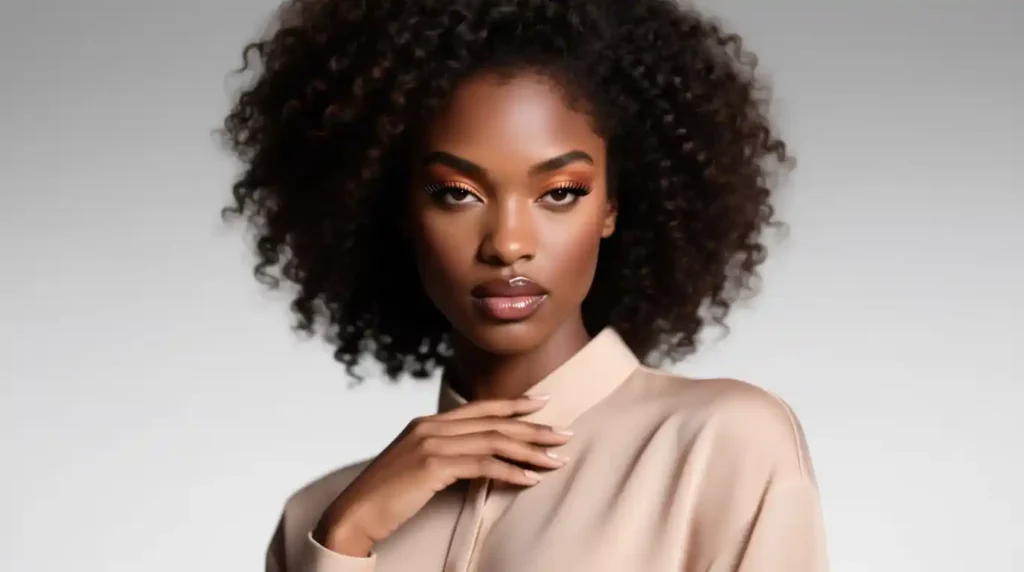
4c hair is the tightest, most coily texture in the natural hair family, full of volume, character, and strength. It’s often seen in natural black hair 4c, known for its rich curls that can shrink up to 75% of their length when dry.
This guide goes beyond the basics you’ll find online. Here’s what most miss:
- Downloadable 4C Hair Chart for quick identification
- Step-by-step styling routines for every length
- Ingredient cheat sheet for healthy growth
- Dedicated men’s 4C hair care section
So, if you’re ready to understand your texture, define your curls, and find the best care for your 4c hair, you’re in the right place.
For a more detailed explanation of hair types and porosity, check out NaturallyCurly’s Guide to Porosity
Understanding the 4C Hair Type
Before you can care for your curls, you need to truly understand your 4c hair type, because this hair isn’t just about curls; it’s about texture, pattern, and personality.
Let’s break it down in simple terms.
The 4C Hair Pattern Explained
4c hair has the tightest curl pattern of all natural hair types. Each strand forms small, spring-like coils or tiny zigzags that may not be easily visible unless you look closely.
A major trait of the 4c hair type is shrinkage, your hair can shrink up to 70–75 % of its actual length when dry. So, shoulder-length hair when wet might look like a short afro when dry, and that’s completely normal.
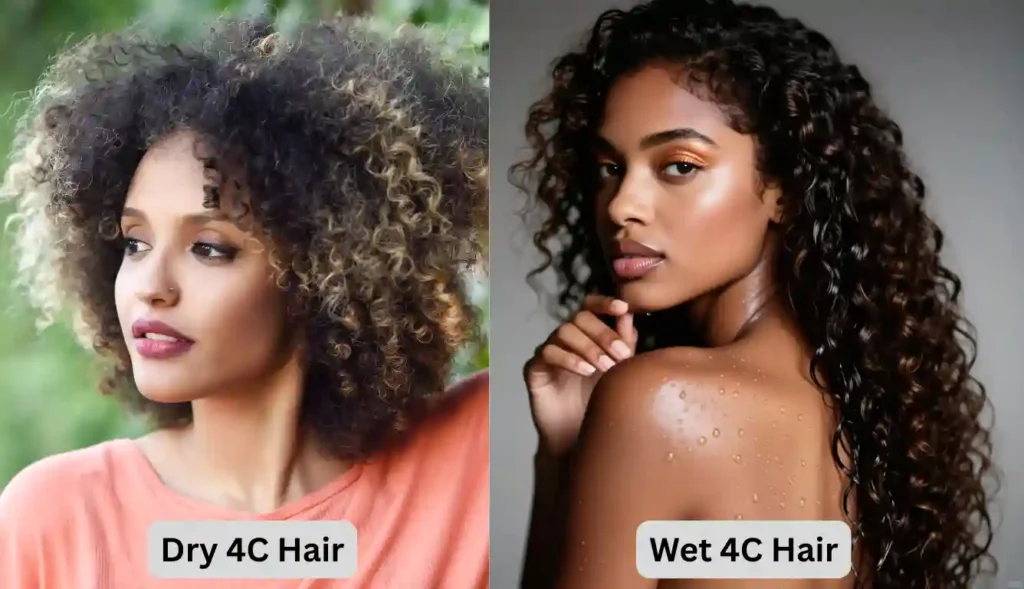
Another thing that makes 4c hair unique is its density and strand width. Some people have fine, delicate coils, while others have thick, wiry strands. Two people can both have 4c hair and still look totally different, that’s the beauty of it.
If you’re wondering, “How do I know if I have 4C hair?”, here’s a quick test:
- Your curls are very tight or almost zigzag-shaped.
- Your hair feels soft or cottony to the touch.
- You notice major shrinkage after washing.
If that sounds like you, welcome to the 4C family!
4B vs 4C Hair, Key Differences
Many people confuse 4b vs 4c hair, but they’re not the same.
Here’s a quick side-by-side breakdown:
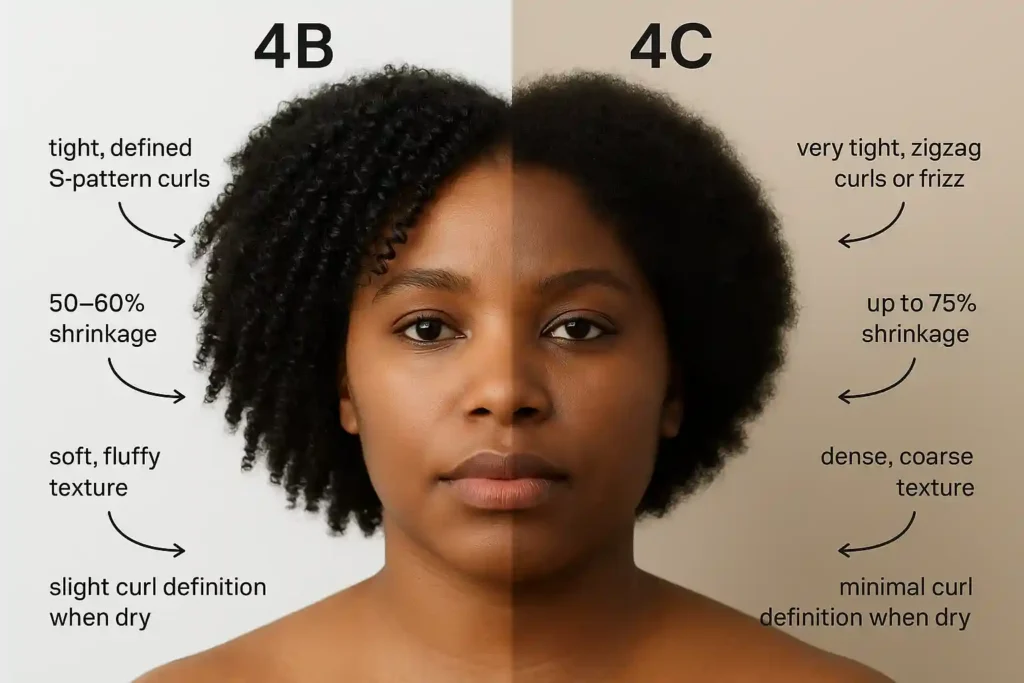
| Feature | 4B Hair | 4C Hair |
| Curl Pattern | Tight, defined S-pattern | Very tight or zigzag, less visible pattern |
| Shrinkage | Around 50–60% | Up to 75% |
| Texture | Softer, fluffier | Denser, coarser |
| Definition When Dry | Slight curl visible | Minimal curl definition |
If you’re still unsure, try this quick check:
- If your twist-out has visible curls, you may have 4B.
- If it looks more like a soft puff with minimal definition, it’s likely 4c hair type.
Quick Takeaway
The 4c hair type isn’t a challenge, it’s a masterpiece of texture and versatility.
When you learn its structure and quirks, caring for 4c hair becomes less about control and more about celebration.
“If you’re curious about how hair care affects your scalp and overall hair health, visit WebMD’s Guide on Hair Loss and Care”
The Science Behind 4C Hair: Why Your Curls Behave the Way They Do
Understanding the science of your 4c hair can make caring for it so much easier. Don’t worry, you don’t need a biology degree for this part! Let’s keep it simple and practical.
Curl Structure, Follicle Shape, and Sebum Flow
Your 4c curly hair is uniquely beautiful because of its tight coil structure and the curved shape of your follicles. Instead of growing straight out of the scalp, each strand of 4c hair grows in a zigzag or spiral pattern.
That curve is what gives your hair its amazing texture, but it also makes it harder for sebum (your scalp’s natural oil) to travel from root to tip. The result? Hair that’s naturally prone to dryness and sometimes feels more fragile.
Think of it like a winding road. On straight hair, oil flows like water down a slide. But on 4c curly hair, it’s more like navigating a mountain trail, slower, with many twists and turns.
“4C hair isn’t weak, it just needs help where nature takes a longer route,” explains Dr. Kendra Hill, a certified trichologist specializing in textured hair”
So, when your 4c hair feels dry, it’s not because it’s unhealthy, it’s just structured differently. That’s why gentle oils, deep conditioning, and regular moisturizing are key.
Porosity, Elasticity & Moisture Retention | Home Tests
Your 4c hair type has its own “personality,” and two of the most important traits to know are porosity (how well your hair absorbs moisture) and elasticity (how well it stretches without breaking).
You can easily test both at home:
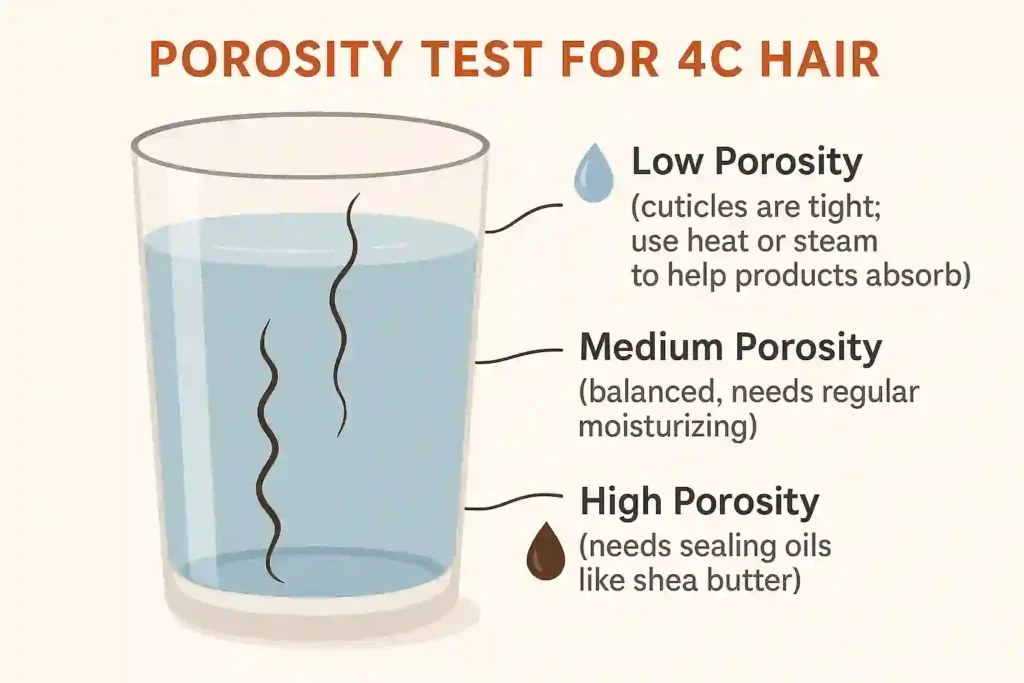
1. Porosity Test
- Take a clean strand of 4c hair.
- Drop it into a glass of water.
- Wait 3–5 minutes.
Results:
- If it floats on top → Low porosity (cuticles are tight; use heat or steam to help products absorb).
- If it sinks quickly → High porosity (needs sealing oils like shea butter).
- If it floats in the middle → Medium porosity (balanced, needs regular moisturizing).
2. Elasticity Test
- Gently stretch a single strand of damp 4c hair.
- If it stretches slightly and bounces back, great elasticity!
- If it snaps easily, it’s craving protein and moisture balance.
Quick Reference Table, Match Porosity to Care
| Porosity Type | Common Signs | What to Use |
| Low | Water beads on hair, takes long to dry | Use lightweight leave-ins + steam treatments |
| Medium | Moisture lasts a few days | Alternate moisture and protein masks |
| High | Always dry, tangles easily | Use rich creams + sealing oils |
Quick Takeaway
Your 4c hair type has science on its side, once you understand how its curls, follicles, and moisture patterns work, you’ll know exactly how to care for it with confidence.
Common 4C Hair Challenges & Myths | What’s Really True?
If you’ve ever wondered “what is 4c hair and why is it so different?”, you’re not alone. Many people with 4c hair face common struggles like dryness, shrinkage, and breakage, but most of these “problems” are simply misunderstood features.
1. Shrinkage: The Illusion of Short Hair
One of the biggest myths about 4c hair is that it “doesn’t grow.”
In reality, 4c hair grows just as fast as any other hair type, around half an inch per month. The difference is shrinkage, which can make long hair look short.
Shrinkage is actually a sign of healthy elasticity! It means your strands are strong enough to bounce back instead of breaking.
2. Dryness & Breakage: A Moisture Management Issue
Many ask, “What damages 4C hair?”
The main culprit is lack of moisture retention, not lack of care. Because of the tight curl pattern, oils from your scalp struggle to coat the strands evenly.
Try this micro-experiment:
3-Week Moisture Challenge: Deep condition weekly, seal with oil, and protect hair at night. You’ll feel a huge difference in softness and manageability.
So, “Does 4C hair grow?” Absolutely yes!
The key is retaining length, through gentle detangling, protective styles, and consistent moisture.
Best Hair Products for 4C Hair | What Actually Works (and Why)
When it comes to 4c hair products, it’s not just about the brand, it’s about the ingredients inside. Understanding what your coils truly need helps you pick products that actually deliver results.
Product Categories & Why They Matter
Let’s break down the key hair products for 4c hair and what they do for your strands:
- Sulfate-Free Shampoos or Co-Washes: Cleanse gently without stripping natural oils. Look for aloe vera or black soap bases.
- Deep Conditioners: Rebuild strength with ingredients like shea butter or hydrolyzed protein.
- Leave-In Conditioners: Add daily softness and help detangle.
- Oils & Butters: Lock in moisture (castor oil, jojoba, shea butter).
- Styling Creams: Define curls while reducing frizz.
- 4c hair moisturizer: Hydrates dry ends between wash days; look for glycerin or honey as humectants.
Ingredient 101: Know Your Moisture Balance
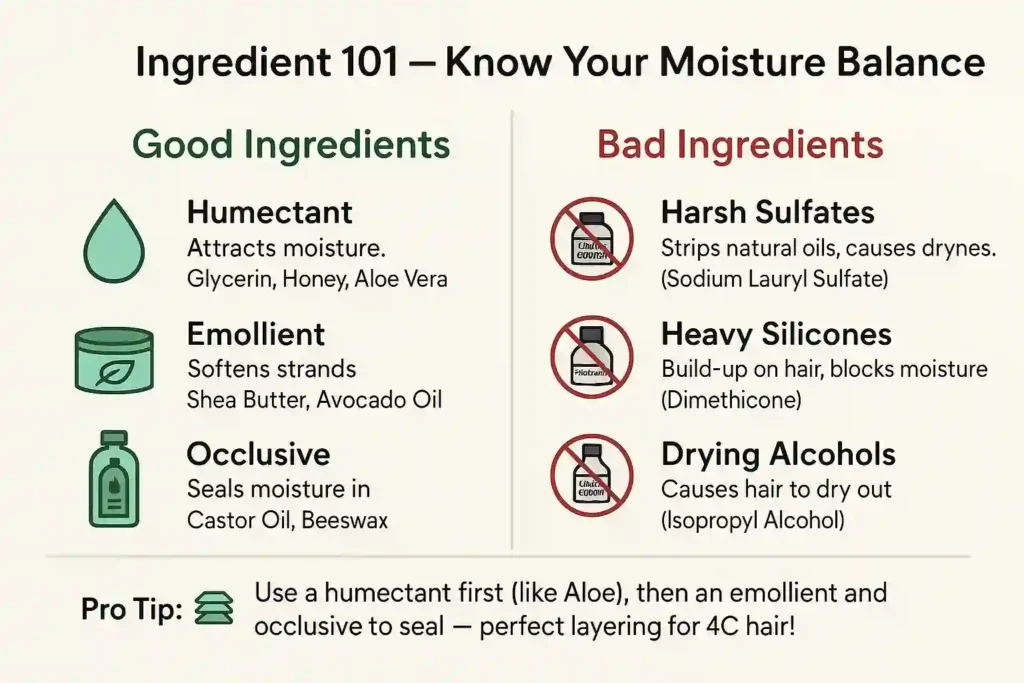
Pro Tip: Use a humectant first (like aloe), then an emollient and occlusive to seal, perfect layering for 4c hair!
What ingredients should I avoid with 4C hair?
Stay away from harsh sulfates, heavy silicones, and drying alcohols (like isopropyl alcohol). They strip your natural oils and increase dryness.
Best Picks by Concern (Real-Life Friendly Choices)
Not every routine fits everyone, here’s how to choose 4c hair products that meet your exact needs:
| Concern | Recommended Type | Why It Works for 4C Hair |
| Dryness | Deep conditioner + oil blend | Replenishes lost moisture and seals ends |
| Low Budget | Co-wash + DIY shea mix | Affordable, minimal ingredients |
| Protein-Sensitive | Moisture-based conditioner | Strengthens gently without stiffness |
| Men-Friendly (4c hair men) | Lightweight leave-in + beard-safe oil | Hydrates hair and beard without buildup |
How to moisturize 4C hair?
Use the L.O.C. method, Liquid (leave-in), Oil, Cream. This keeps moisture sealed for days, especially in dry climates.
Styling Inspiration & How-Tos for 4C Hair You’ll Love
Styling 4c hair should never feel like a chore, it’s a way to show off your texture’s beauty, creativity, and versatility. Whether your curls are short or long, these 4c hair styles are easy, protective, and beginner-friendly.
Everyday Styles & Protective Options
Looking for effortless hairstyles for 4c hair that protect your strands while keeping you stylish? Try these favorites:
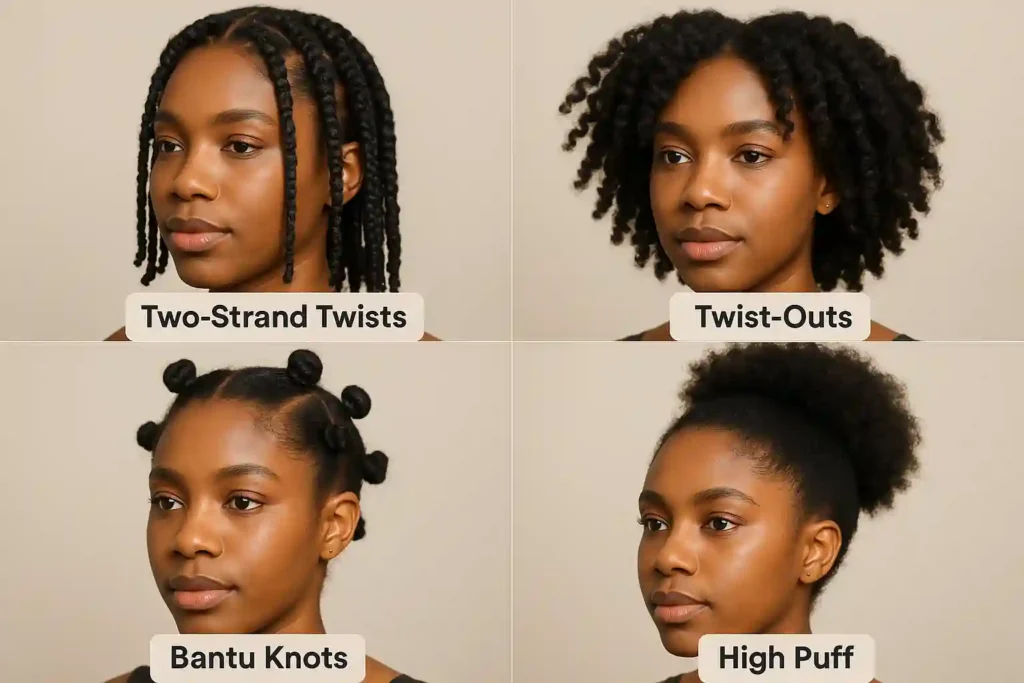
- Two-Strand Twists: Divide your hair into sections, twist two strands together, and seal the ends with cream. Great for definition and stretch.
- Twist-Outs: Undo your twists for bouncy, soft coils, perfect for a casual day out.
- Bantu Knots: Coil and wrap sections into small buns, protective and super chic.
- High Puff or Puff-Out: Gather hair at the crown for a bold, elegant look.
Short 4C Hair Looks & Quick Routines
Short hair? No problem! Short 4c hair shines with creative cuts and 5-minute routines. Try sponge coils, finger curls, or tapered cuts that frame your face.
Busy mornings? Keep a 10-minute checklist, spritz water, apply leave-in, oil, and go!
Long 4C Hair Care & Styles
For long 4c hair or 4c curly hair, focus on retention, protective styles like braids, flat twists, and low buns reduce breakage.
Always use heat-protectant sprays before blow-drying or stretching to keep strands safe.
Quick Takeaway
Your 4c hair styles can be bold or simple, what matters most is consistency and creativity. With care and confidence, your coils can do it all!
4C Hair Care for Men: Simple, Stylish & Smart
Caring for 4c hair men doesn’t have to be complicated. Whether you keep your curls short or rock a mini afro, consistency is what keeps your texture healthy and defined.
Morning Routine
Start by misting your natural black hair 4c with water or a hydrating spray. Then apply a lightweight leave-in conditioner or curl cream to lock in moisture.
For shorter styles, finish with a soft brush or sponge to shape your curls. If you’re growing your hair, add a few drops of oil (like jojoba or castor) to seal hydration.
Pro Tip: Use the same oil blend for both your beard and hair, it keeps your look balanced and saves time.
Night Routine
Before bed, cover your 4c hair male style with a satin durag or bonnet. This prevents friction, dryness, and breakage overnight.
If you have a beard, massage in a small amount of conditioner or beard oil to keep it soft and even.
Barber & Product Tips
When visiting your barber, ask for shape-ups that follow your natural curl pattern, not against it.
| Product Type | Why It Helps | Example Ingredient |
| Leave-in | Keeps curls defined | Shea butter |
| Oil blend | Locks moisture | Castor oil |
| Beard balm | Adds shine & control | Argan oil |
The Ultimate 4C Hair Routine: Daily, Weekly & Monthly Playbooks
Healthy 4c hair thrives on routine, not random care. Think of it like a gym plan, your curls need consistent “training” to stay hydrated, strong, and defined.
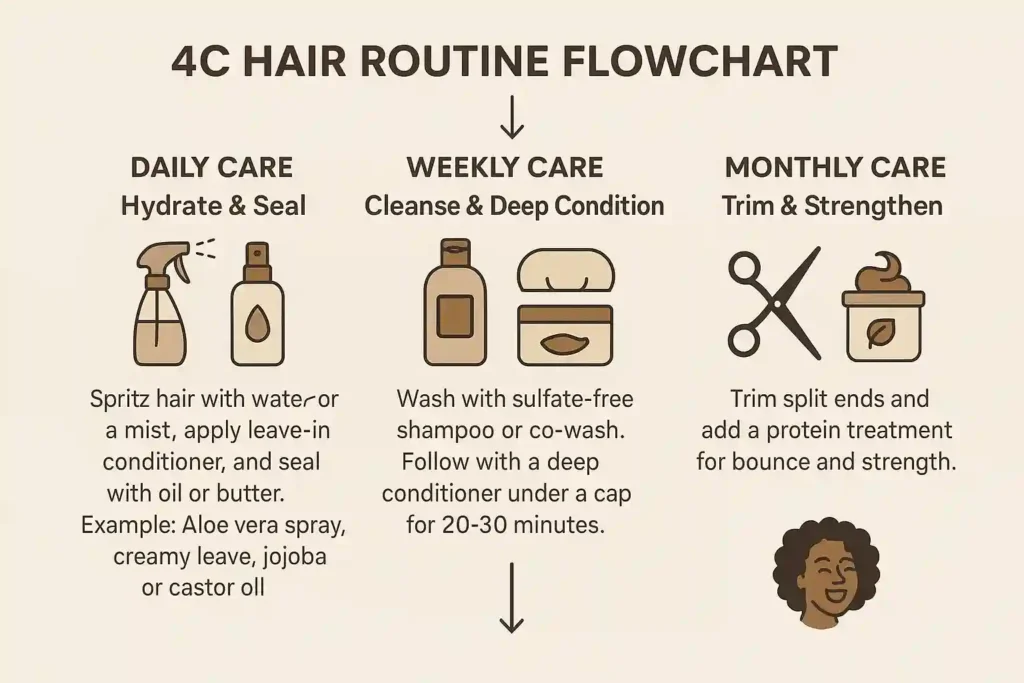
Daily: Hydrate & Seal
Your 4c curly hair loves moisture but loses it fast. Each morning, spritz your strands with water or a light mist, then apply a leave-in conditioner followed by oil or butter to seal in that moisture.
Example combo: Aloe vera spray + creamy leave-in + a few drops of jojoba or castor oil.
–> Should you wet 4C hair every day?
Yes, lightly misting daily helps prevent dryness and breakage, especially in dry climates.
Weekly: Cleanse & Deep Condition
Wash your 4c hair type once a week using a sulfate-free shampoo or co-wash. Follow up with a rich deep conditioner under a shower cap for 20–30 minutes. This restores elasticity and shine.
–> How often should you wash 4C hair?
Once a week is ideal, more often can strip natural oils, less can lead to buildup.
Monthly: Trim & Strengthen
Once a month, do a light trim to remove split ends. Add a protein treatment if your curls feel limp or overly soft, it rebuilds structure and bounce.
Pro tip: Adjust your products seasonally, use heavier butters in dry weather and lighter creams when it’s humid.
Caring for Chemically Treated or Colored 4C Hair, Keep the Color, Not the Damage
Coloring or relaxing 4c hair can look stunning, but it also makes your strands more fragile. The key is balance: moisture, protein, and patience.
Step 1: Gentle Cleansing & Safe Color Care
After coloring, avoid harsh shampoos for at least a week. Use sulfate-free 4c hair products or co-washes that protect both your curl pattern and color. Look for ingredients like aloe vera, shea butter, and argan oil, they help lock in color and softness.
Step 2: Moisture: Protein Balance
Chemically treated 4c hair loses both moisture and protein. Alternate between moisturizing masks (like honey or avocado-based) and protein treatments every two weeks.
Think of it as rebuilding your hair’s “armor” while keeping it hydrated and flexible.
Step 3: Detangle & Heat with Care
Always detangle while your hair is wet and coated in conditioner, never dry. Use a wide-tooth comb or your fingers to avoid breakage.
If you use heat, apply a silicone-free heat protectant and keep tools below 350°F to prevent further damage.
4C Hair FAQs: Quick Answers to Your Top Questions
What damages 4C hair?
Overuse of heat tools
Skipping moisture
Harsh chemical treatments
Tight protective styles
Prevent damage with regular deep conditioning and gentle detangling.
Should you wet 4C hair every day?
Not always. Mist with water or a leave-in instead of soaking, it hydrates without over-manipulation.
How to moisturize 4C hair / best moisturizer?
Use a 4c hair moisturizer rich in shea butter or glycerin. Seal with oil to lock it in.
Can 4C hair grow long / how to grow 4C hair faster?
Yes! It grows like all hair, it just needs protection from breakage. Follow a consistent moisture + trim routine to see real results
You will love to read these articles:
1.Best Curly Hairstyles for Women 2025: Short, Long & Trendy Looks to Try
2. Ripped Bob Haircut: The Textured Bob Trend Taking Over Fall 2025
3.Top 10 Hairstyles for Women Over 50 That Make You Look Younger
